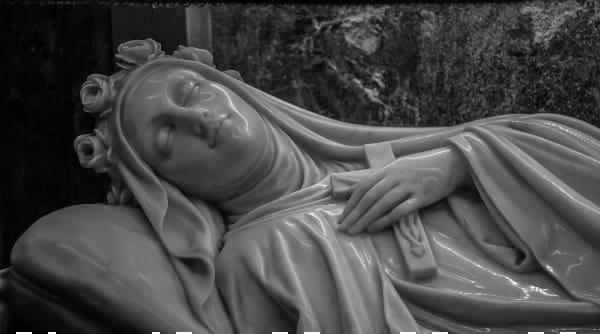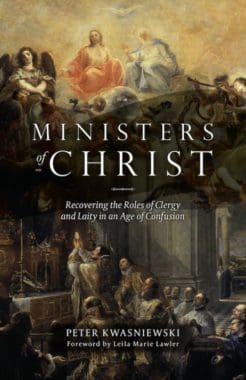One of the most beloved and powerful of modern saints, St. Thérèse of the Child Jesus and of the Holy Face, is a wonderfully attractive model of a Catholic fully engaged in the liturgy without having to be a liturgical minister. She tells us why her contribution, though different from the priest’s, is no less valuable, no less precious in God’s sight.
Many readers will be familiar with a photograph of St. Thérèse in which she is shown posing in her work of filling a ciborium with hosts (among other typical functions of a sacristan) for the daily conventual Mass. This is in keeping with the usual customs of convents, where the sisters perform many of the tasks that would otherwise be assigned to clerics, such as leading the entire Divine Office, chanting its readings and prayers, and making the responses at low Mass from outside the sanctuary in situations when no servers are available.
A photo that is much less known, and which I myself saw only for the first time recently, shows Thérèse with (if I may say so) her liturgical assistants in November 1896. Three of them are her biological sisters Marie, Pauline, and Céline: Sr. Marie of the Sacred Heart, Mother Agnes of Jesus, and St. Geneviève of the Holy Face. One is her aunt Marie Guérin, known to us as Sr. Marie of the Eucharist. Sr. Marie of the Eucharist, Sr. Marie of the Angels (not in the photo), and St. Thérèse were the sacristans, while her three biological sisters were altar bread bakers.
St. Thérèse was a gifted amateur poet and playwright who composed a surprising number of literary works in her spare moments during her nine years as a Carmelite nun. Some of her work was intended for communal occasions such as recreations, birthdays, and feast days, while other pieces were more private, sent to one or a few of her religious sisters. In the same month of November 1896, she wrote a poem called “The Sacristans of Carmel” in rhyming, octosyllabic verse. The poem was written for Sr. Marie Philomena, who had asked Thérèse for something she could sing while baking, but it was first read by her aunt. Later, all of the sacristans and altar bread bakers got to know the poem and apparently sang it regularly in their work, to whatever familiar tune they chose that would match the meter. In this, we see a splendid example of the genre of a “work song” that has nearly disappeared from the world of mass-marketed and passively consumed entertainment. One may hope such work songs still survive in the Carmels.
The religious and theological content of the song is quite worthy of attention:
Here below our sweet office
Is to prepare for the altar
The bread and wine of the Sacrifice
Which brings to earth—“Heaven!”
Heaven, O supreme mystery!
Hides itself under humble bread;
For Heaven is Jesus Himself,
Coming to us each morning.
There are no queens on earth
Who are happier than we.
Our office is a prayer
Which unites us to our Spouse.
The greatest honors of this world
Cannot compare
To the peace, profound and heavenly,
Which Jesus lets us savor.
We bring a holy envy
For the work of our hands,
For the little white host
Which is to veil our divine Lamb.
But His love has chosen us.
He is our Spouse, our Friend.
We are also hosts,
Which Jesus wants to change into Himself.
Sublime mission of the Priest,
You become our mission here below.
Transformed by the Divine Master,
It is He who guides our steps.
We must help the apostles
By our prayers, our love.
Their battlefields are ours.
For them we fight each day.
The hidden God of the tabernacle
Who also hides in our hearts,
O what a miracle! at our voice
Deigns to pardon sinners!
Our happiness and our glory
Is to work for Jesus.
His beautiful Heaven is the ciborium
We want to fill with souls!
The Carmelite commentators find this poem both charming and insightful:
The sacristans are the untiring agents of this mysterious exchange [between heaven and earth]. In this poem, they readily call to mind something like Jacob’s ladder. These stanzas are full of “gentleness.” There is the discreet gentleness of the “housewife,” if we dare call it that: of the spouse “happier than a queen” whose heart remains attentive to her Husband, while her hands are diligently working for Him. There is also the discreet gentleness of the Carmelite nun, who is associated with the apostle at the altar in the role that is hers, that of the hidden companion. In both cases, the assistant becomes like the one she assists.
Here she [Thérèse] sings of her concrete way of sharing immediately in the “sublime mission of the Priest.” “Transformed” into Jesus by the Eucharist, “changed” into Him, does she not then also become an “alter Christus” [another Christ]…? She cannot leave her cloister to “preach the Gospel,” but Jesus, the first Missionary, walks in her and through her. He “guides her steps,” as He does those of the apostles she prays for, loves, and struggles for. She cannot absolve from sins. But Jesus present in her through the Eucharist gives her a share in his ministry of reconciling sinners. She will never fill the ciborium with consecrated hosts. But she is spending her life “filling Heaven with souls”—living hosts in which Christ lives alone from then on…. So Thérèse has no inferiority complex toward “men” or priests. She has no presumption either. For her, it is Jesus who acts in collaboration with men—and women. Even in 1892, she wrote to Céline: “I find that our share is really beautiful; what have we to envy in priests?”
In fact, though the expression “holy envy” is awkward, it conveys a truth: it will always be the case that each Christian vocation has reason to admire the goods of every other, since these goods are not, simply speaking, compatible with one another. The priest may well “envy” the female religious her total and silent dedication to prayer, which he will almost never attain in his active ministry. The married man or woman may “envy” the consecrated soul its undivided attentiveness or availability for the things of the Lord (cf. 1 Cor. 7). The consecrated man or woman may “envy” the married their sacramental realization of the faithful, fruitful union of Christ and the Church, which brings new immortal souls into the world to complete the number of the elect.
In the Mother of God alone do we find united that which nature cannot unite, combining and exceeding all Christian states of life: she is the “bride unwedded,” the child-bearing virgin, mother inviolate, and Mediatrix of all grace as the inseparable helpmate of the High Priest. In her, all vocations are at one, like white light before it splinters into a spectrum of colors. For the rest of us, the individual colors are distinct, complementary, and beautiful, as they are intended to be for our individual benefit and for the common good of the Church.
St. Thérèse’s poem serves as a profitable meditation on several intertwined mysteries: the unique, exalted, and irreplaceable nature of the ministerial priesthood; the lofty participation in Christ the High Priest enjoyed by all who are baptized into His sacerdotal and royal dignity; the special position of consecrated religious, who follow the priestly and sacrificial Lamb whithersoever He goeth; and the value in God’s sight of the quiet, humble work done by sacristans whenever they reverently prepare the materials and environs required for worthily offering the sacrifice of praise.
+
This article is adapted from a chapter in Ministers of Christ by Dr. Peter Kwasniewski which is available from Sophia Institute Press.
Art for this post: Cover and featured image used with permission.





